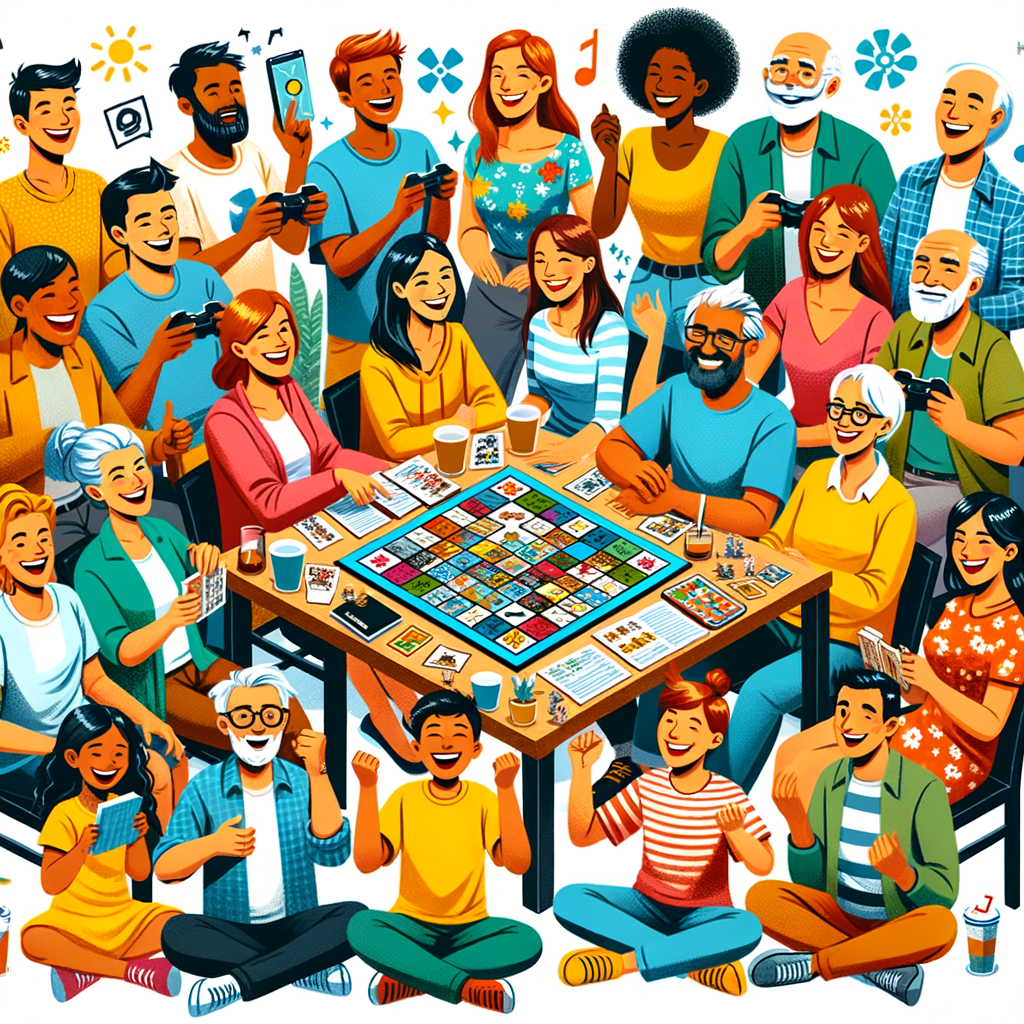Introduction to Board Gaming Diversity
Board games have been a source of entertainment for centuries, bringing people together for fun and friendly competition. In recent years, there has been a growing awareness of the need for diversity and inclusivity in board games. This article will explore these topics in depth, providing a comprehensive overview of the importance of diversity in board games and the role of inclusivity in creating a more engaging and enjoyable gaming experience for all.
- Understanding the concept of diversity in board games
Diversity in board games refers to the representation of different cultures, races, genders, and abilities in the game’s design, characters, and themes. This can be seen in the artwork, game mechanics, and narratives that make up the game. For example, a game might feature characters of different races or genders, or it might incorporate elements of various cultures in its design. The goal is to create a game that is reflective of the diverse world we live in, allowing players of all backgrounds to see themselves represented and feel included.
- Importance of inclusivity in games
Inclusivity in games is about ensuring that everyone, regardless of their background or identity, can enjoy the game. This means creating games that are accessible and welcoming to all players. Inclusivity can be achieved in many ways, such as by providing options for different skill levels, ensuring that game instructions are clear and easy to understand, and avoiding stereotypes or offensive content. Inclusive games not only create a more enjoyable experience for all players, but they also help to promote understanding and empathy among different groups of people.
As we delve deeper into the topic, we will explore the evolution of inclusivity in games, take a closer look at diversity in board games, and discuss the future of inclusivity in the gaming industry. Stay tuned for a fascinating journey into the world of board gaming diversity.
The Evolution of Inclusivity in Games
 As we explore the journey of inclusivity in games, let’s start from the beginning. The early days of board games were not as diverse as they are today. Let’s take a closer look.
As we explore the journey of inclusivity in games, let’s start from the beginning. The early days of board games were not as diverse as they are today. Let’s take a closer look.
The Past: A Look at Early Board Games
Board games have been a part of human culture for thousands of years. However, the representation of different cultures, genders, and races was not always a priority in these early games.
Representation in early board games
Early board games often reflected the societies in which they were created. For example, in games like Chess and Monopoly, the characters and roles were predominantly male and white. This lack of diversity limited the perspectives and experiences that these games could offer.
Challenges faced in promoting diversity in early games
There were many obstacles to promoting diversity in early board games. One of the main challenges was societal attitudes. In the past, society was less accepting of diversity, which was reflected in the games of the time. Additionally, the game industry was dominated by a small group of people who shared similar backgrounds and perspectives, making it difficult for diverse voices to be heard.
Despite these challenges, there were some early pioneers who sought to promote diversity in board games. For example, Elizabeth Magie, the creator of The Landlord’s Game, the precursor to Monopoly, used her game to promote social and economic equality.
These early efforts laid the groundwork for the more inclusive games we see today. As we continue to evolve, we must remember the lessons of the past and strive to create games that reflect the diversity of our world.
The Present: Modern Inclusive Games
Today’s board games have evolved significantly from their predecessors, with a focus on promoting diversity and inclusivity. Let’s delve into how modern board games are achieving this and explore some examples of inclusive games.
- How modern board games promote diversity
Modern board games are consciously designed to promote diversity in various ways. They are increasingly featuring characters of different races, genders, and backgrounds, and incorporating themes that highlight different cultures and experiences. This not only makes the games more relatable to a wider audience but also fosters understanding and empathy among players.
For instance, many games now offer a choice of characters that players can identify with, regardless of their race, gender, or cultural background. This is a significant shift from the past when characters in board games were predominantly white and male.
Moreover, game developers are making efforts to ensure that the rules and gameplay do not favor any particular group of players. This creates a level playing field and encourages participation from all players.
- Examples of modern inclusive games
There are numerous examples of modern board games that promote diversity and inclusivity. Here are a few:
- Wingspan: This game, designed by Elizabeth Hargrave, features birds from all over the world, promoting biodiversity and environmental awareness. It also stands out for being created by a female designer in an industry that is often male-dominated. (source)
- Spirit Island: In this cooperative game, players take on the roles of different spirits defending their island from colonizers. The game flips the script on the traditional colonization narrative and encourages players to empathize with the indigenous spirits. (source)
- Codenames Duet: This is a cooperative version of the popular game Codenames, designed to be more inclusive and accessible. It can be played by two players or more, and the game’s clues can be tailored to suit players of different ages and backgrounds. (source)
In conclusion, modern board games are making significant strides in promoting diversity and inclusivity. By featuring diverse characters and themes, and ensuring fair gameplay, these games are becoming more accessible and appealing to a wider audience.
Diversity in Board Games: A Closer Look
In this section, we delve deeper into the concept of diversity in board games. We’ll explore how diversity is celebrated and provide case studies of games that have successfully incorporated it.
Celebrating Diversity in Gaming
Board games have long been a source of entertainment, but they’re also a reflection of our society. As our world becomes more diverse, so too do our games. Let’s take a closer look at how diversity is celebrated in board games.
- How diversity is celebrated in board games
Board games celebrate diversity in various ways. Some games feature characters of different races, genders, and backgrounds, allowing players to see themselves represented in the game. Others go a step further by incorporating diverse cultures and experiences into the gameplay itself. For instance, the game Ticket to Ride takes players on a train journey across different countries, introducing them to various cultures along the way.
- Case studies of board games that celebrate diversity
Let’s look at some specific examples of board games that celebrate diversity:
| Game | Description |
|---|---|
| Catan | In Catan, players are settlers establishing colonies on the island of Catan. The game includes characters of different genders and backgrounds, promoting diversity and inclusion. |
| Pandemic | Pandemic is a cooperative game where players work together to stop the spread of diseases. The game features a diverse cast of characters, each with their unique abilities, emphasizing the importance of teamwork and collaboration. |
In conclusion, diversity in board games is not just about representation. It’s about creating an inclusive environment where everyone feels seen and valued. By celebrating diversity, board games can help foster understanding and empathy among players, making our world a little bit better one game at a time.
Inclusive Board Gaming: Beyond Representation
When we talk about inclusivity in board games, it’s not just about having diverse characters. It’s about creating a gaming environment that is welcoming and accessible to everyone, regardless of their background or abilities. Let’s take a closer look at how inclusivity goes beyond representation in board games and explore some examples of inclusive gaming mechanics.
- How inclusivity goes beyond representation in board games
Inclusivity in board games is more than just representing different races, genders, and cultures. It’s about creating games that are accessible and enjoyable for everyone. This means considering factors like game complexity, language barriers, and physical accessibility. For instance, a game with simple rules and clear, easy-to-read text can be enjoyed by players of different ages and abilities. Similarly, a game that includes options for colorblind players or those with physical disabilities is more inclusive.
- Examples of inclusive gaming mechanics
There are many ways to incorporate inclusivity into the mechanics of a board game. For example, cooperative games, where players work together towards a common goal, can be more inclusive as they encourage teamwork and communication. Games that offer multiple paths to victory can cater to different play styles and strategies, making them more accessible to a diverse range of players. Additionally, games that provide options for adjusting difficulty levels or game length can accommodate players with different skill levels and time constraints.
As we can see, inclusivity in board games goes far beyond representation. It’s about creating games that are accessible and enjoyable for everyone, regardless of their background or abilities. By incorporating inclusive gaming mechanics, we can create a more welcoming and inclusive gaming community.
Modern Board Games Diversity: Key Takeaways
As we delve into the world of modern board games, it is essential to highlight the key insights that we have gathered about diversity and inclusivity in this realm. Here are the main takeaways:
The Importance of Diversity and Inclusivity in Board Games
Diversity and inclusivity in board games are not just about ticking boxes; they play a significant role in shaping the gaming experience. Board games are a reflection of our society, and when they incorporate diverse characters and themes, they become more relatable and enjoyable for everyone. They also help in fostering understanding and empathy among players of different backgrounds. According to a Wikipedia article, board games have a social aspect that can help bridge cultural and societal gaps.
How Modern Board Games are Leading the Way in Promoting Diversity
Modern board games are making remarkable strides in promoting diversity. They are breaking away from traditional stereotypes and introducing characters and narratives that represent a wide range of cultures, races, genders, and abilities. For instance, games like “Ticket to Ride” and “Pandemic” feature diverse geographical locations, encouraging players to learn about different cultures and regions. Moreover, games like “Photosynthesis” and “Wingspan” are breaking gender stereotypes by focusing on themes like nature and wildlife, which are enjoyed by all.
In conclusion, diversity and inclusivity in modern board games are not just trends; they are necessary for creating games that are engaging, educational, and representative of our diverse world. The future of board gaming looks promising as more and more game developers are realizing the importance of these aspects and incorporating them into their games.
Board Games and Inclusivity: The Future
As we look towards the future, it’s clear that diversity and inclusivity will continue to play a significant role in the world of board games. Let’s explore some predictions and ways in which players can actively support and promote diversity.
- Predictions for the future of diversity and inclusion in board games
Experts predict that diversity and inclusion will become even more prominent in board games. Game designers are becoming increasingly aware of the need for representation, and this is likely to be reflected in future releases. We can expect to see more games featuring characters of different races, genders, and abilities, as well as games that explore diverse cultures and experiences.
One trend that’s likely to continue is the incorporation of diverse themes and narratives. This not only makes games more interesting and engaging, but also allows players to learn about and appreciate different perspectives. For example, a game might explore the experiences of immigrants, or delve into the history and culture of a particular ethnic group.
Another prediction is that there will be more opportunities for people from diverse backgrounds to get involved in the game design process. This could lead to the creation of games that are more authentic and inclusive, and that truly reflect the diversity of the gaming community.
- How players can support and promote diversity in board games
As players, we all have a role to play in promoting diversity and inclusion in board games. Here are a few ways you can make a difference:
- Support diverse game designers: Seek out and purchase games created by designers from diverse backgrounds. This not only supports these designers, but also helps to ensure that a wide range of voices and perspectives are represented in the gaming industry.
- Speak up for diversity: If you notice a lack of diversity in a game, don’t be afraid to speak up. You can write to the game’s creators or publishers, or post about it on social media. Your voice can help to bring about change.
- Play with a diverse group: Try to play games with a diverse group of people. This can lead to more interesting and enriching gaming experiences, and can also help to promote understanding and acceptance.
In conclusion, the future of board games looks bright, with diversity and inclusivity set to play an increasingly important role. By supporting diverse game designers and speaking up for diversity, we can all help to shape this future and ensure that board games are a space where everyone feels welcome and represented.
Conclusion: Celebrating Inclusivity in Modern Games
As we conclude our exploration of diversity and inclusivity in modern board games, it’s clear that the landscape of gaming has significantly evolved. Today, we celebrate the strides made in creating a more inclusive gaming environment that reflects the diverse world we live in.
Recap of the rise of diversity in board gaming
From the early days of board gaming, when representation was limited, we’ve seen a remarkable shift. The rise of diversity in board games is a testament to the industry’s commitment to inclusivity. Games today feature characters and narratives from a wide array of cultures, backgrounds, and experiences. This shift is not just about representation; it’s about creating a space where everyone feels seen, heard, and valued. For instance, Catan, a popular board game, has made efforts to include diverse characters and narratives in its gameplay.
Final thoughts on the importance of inclusivity in games
Inclusivity in games is more than a trend; it’s a necessity. Games are a reflection of our society, and as such, they should represent the diversity of the people who play them. Inclusive games foster empathy, understanding, and respect for different cultures and experiences. They allow players to see the world from different perspectives, promoting a more inclusive and understanding society.
As we look towards the future, let’s continue to champion diversity and inclusivity in board games. Let’s celebrate the games that reflect the world’s diversity and encourage others to follow suit. After all, everyone should have the chance to see themselves in the games they play.
Remember, a board game is not just a source of entertainment; it’s a tool for social change. By embracing diversity and inclusivity, we can use games to build a more understanding and inclusive world.



